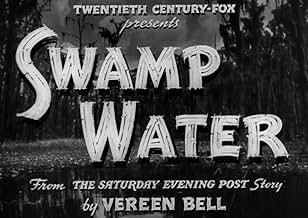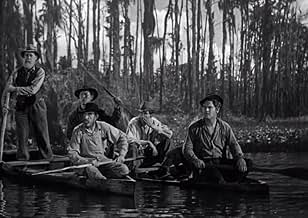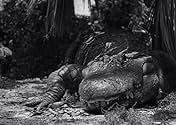NOTE IMDb
7,0/10
2,3 k
MA NOTE
Alors qu'il tente de retrouver son chien perdu dans un vaste marécage de Géorgie, Ben Ragan tombe sur un meurtrier recherché, Tom Keefer, qui convainc Ben qu'il a été piégé par le vrai tueur... Tout lireAlors qu'il tente de retrouver son chien perdu dans un vaste marécage de Géorgie, Ben Ragan tombe sur un meurtrier recherché, Tom Keefer, qui convainc Ben qu'il a été piégé par le vrai tueur.Alors qu'il tente de retrouver son chien perdu dans un vaste marécage de Géorgie, Ben Ragan tombe sur un meurtrier recherché, Tom Keefer, qui convainc Ben qu'il a été piégé par le vrai tueur.
- Réalisation
- Scénario
- Casting principal
Guinn 'Big Boy' Williams
- Bud Dorson
- (as Guinn Williams)
Joe Sawyer
- Hardy Ragan
- (as Joseph Sawyer)
Paul E. Burns
- Tulle McKenzie
- (as Paul Burns)
Audley Anderson
- Townsman
- (non crédité)
Nora Bush
- Townswoman
- (non crédité)
Avis à la une
Only viewed this movie once,when as an eleven year old , it first opened. I still recall the scene where Julie scurried away through the barn to hide from Andrews. Clawing like a black cat (with her raven hair matted as if it were a Brillo Pad.) I instantly fell head over heels in love with that gruff looking girl.
The fight scene , the cottonmouth attack still looms large in my memory. I'm 76 now, but would love to see it twenty more times and hark back to those innocent days, when a nickle candy bar could be bought for five cents .
Excellent movie (Also loved The Southerner)
The fight scene , the cottonmouth attack still looms large in my memory. I'm 76 now, but would love to see it twenty more times and hark back to those innocent days, when a nickle candy bar could be bought for five cents .
Excellent movie (Also loved The Southerner)
Having seen almost all Renoir's works, I was eager to see this one, the master's first film of his american stint. If you have seen Renoir's The River (1951), one of his loveliest masterpieces, the feeling cames to you, when you are watching this 1941 movie, that you are seeing just a preparatory exercise for that later piece of art. Just listen Walter Brennan's lines when he first meet Dana Andrews about how the death of an individual begets new life elsewhere.
Sometimes also in the movie I had the resemblance of watching a John Ford movie, specially in the town scenes, more obvious in the ball scenes, the guy with the girl chatting, the dancers background, and suddenly a huge thug coming out, and the fight therefore. More hints about this: the writer is Dudley Nichols, a Ford habitual collaborator, and among the cast, John Carradine and Ward Bond, also from Ford's troup. Anyway, it's a Renoir. Watch it (it's short and pleasant, and hide two or three great moments.)
Sometimes also in the movie I had the resemblance of watching a John Ford movie, specially in the town scenes, more obvious in the ball scenes, the guy with the girl chatting, the dancers background, and suddenly a huge thug coming out, and the fight therefore. More hints about this: the writer is Dudley Nichols, a Ford habitual collaborator, and among the cast, John Carradine and Ward Bond, also from Ford's troup. Anyway, it's a Renoir. Watch it (it's short and pleasant, and hide two or three great moments.)
I can remember seeing this movie as a kid and getting the bejesus scared out of me. The darkness and uncertainty of the swamp terrified my young imagination and the image of the skull atop a cross touched all my Roman Catholic primal fears. My impression of the swamp, i.e., crocs, gaters and snakes, topped with a dark image of the fugitive played by Walter Brennan, lasted for years. Now, I do recall there being a video (although none is listed here), because I did see it again a few years back. The shock of the darkness of the film was dulled by over 50 years of life but the Gothic quality of the story along with the fine characterization of Renoir makes this film a classic. Walter Huston is great in his curmudgeon role as the young Dana Andrews's father married to a younger woman who's getting moves laid on by ever villainous John Carridine. The presence of great character actors Guinn"Big Boy" Williams, Ward Bond and gravel-voiced Eugene Palette adds much to the texture of the film. Too, the young Anne Baxter is superb as the daughter of Brennan and the female interest of Dana Andrews. The story line seems a bit tame, by today's standards but holds up well. All in all, this is a satisfying film well done and provocative. Check it out.
While participating in a posse to hunt down the fugitive Tom Keefer (Walter Brennan), who is accused of murdering a local inhabitant, the young Ben Ragan (Dana Andrews) loses his dog Trouble in the Okefenokee Swamp in Georgia. He returns to the swamp to seek his dog out but he is captured by Tom. Soon he learns that Tom Keeler is innocent and has a daughter, Julie (Anne Baxter), who is raised by the local merchant Marty McCord (Russell Simpson). Ben has an argument with his father Thursday Ragan (Walter Huston) and he moves to a shanty that belongs to Marty. Then he associate to Tom Keeler to hunt animals in the swamp and he shares the profit of selling furs with Julie. Soon they fall in love with each other. One day, Ben witnesses Bud Dorson (Guinn Williams) and his brother Tim Dorson (Ward Bond) stealing Marty's pigs. There is a meeting in the village with Sheriff Jeb McKane (Eugene Palette) to find the thief and Ben's ex-girlfriend Mabel MacKenzie (Virginia Gilmore) is jealous of Ben and accuses Tom Keefer. The sheriff organizes a search party to hunt Tom down, but Ben presses Jesse Wick (John Carradine), who is harassing his stepmother Hannah (Mary Howard), and he finds who the real killers are. He wants Tom to return to the village, but Tom suspects that Ben might intend to betray him.
"Swamp Water" is an entertaining and dramatic adventure. The locations and the camera work in the swamp are impressive. The choreography of the fight and the quick sand in the swamp "swallowing" the criminal are very realistic. The direction of Jean Renoir and the cinematography are amazing. My vote is seven.
Title (Brazil): "O Segredo do Pântano" ("The Secret of the Swamp")
"Swamp Water" is an entertaining and dramatic adventure. The locations and the camera work in the swamp are impressive. The choreography of the fight and the quick sand in the swamp "swallowing" the criminal are very realistic. The direction of Jean Renoir and the cinematography are amazing. My vote is seven.
Title (Brazil): "O Segredo do Pântano" ("The Secret of the Swamp")
If one had missed the opening credits, he would be forgiven for thinking that 'Swamp Water (1941)' was one of John Ford's lesser-known efforts. If the cast of familiar Ford faces including Walter Brennan, Ward Bond and John Carradine didn't lead you up the wrong path, then it's the smaller touches that characterise the director's Westerns: a close-knit community, an impassioned brawl, an innocent young lass, a significant father-son relationship. In this case, however, the credit doesn't belong to one of America's greatest filmmakers, but to the French equivalent {though it comes as no surprise that writer Dudley Nichols was a frequent Ford collaborator}. 'Swamp Water' was Jean Renoir's first picture following his migration to Hollywood in the early 1940s. Interestingly, considering the distinctive brand of auterist film-making evident in 'The Rules of the Game (1939)' just two years earlier, there's little here to suggest that Renoir is seated behind the camera. Aside from a waterbound opening shot that calls to mind several scenes from 'A Day in the Country (1936),' this film bears little resemblance to the other seven Renoirs I've seen to date.
When hunter Ben Ragan (Dana Andrews, in an early role) ventures into the feared Okefenokee swamp to retrieve his lost dog, he happens upon the hiding-place of Tom Keefer (Walter Brennan), a convicted murderer who escaped custody and has been living in isolation for several years. Despite having become a rugged and slightly eccentric recluse, Keefer firmly professes his innocence and spares Ben's life, in exchange for keeping silent about his whereabouts. Back in town, and to his sweetheart's (Virginia Gilmore) chagrin, Ben befriends Keefer's daughter Julie (Anne Baxter), a raggedy young beauty who shies away from social interaction like a frightened kitten {fortunately for her career, Baxter would play a substantially more independent character in Wilder's 'Five Graves to Cairo (1943),' and I certainly don't need to mention 'All About Eve (1950)'}. Meanwhile, Ben's father Thursday (Walter Huston) watches out for the cowardly ruffian who has been bothering his younger wife Hannah (Mary Howard) the perpetrator is, of course, the suitably pathetic John Carradine.
Even if it doesn't attain the dizzying heights of Renoir's other offerings, 'Swamp Water' deserves to be seen for his marvellous and atmospheric cinematography (the stifling swamp photography was captured by Peverell Marley) and strong performances. Andrews perhaps wasn't the most authentic actor of the 1940s, but here he plays the young hero with a tenacity that signalled a successful future in Hollywood. Huston is, of course, terrific, and I've found it interesting that he never seems to play the same character (to such an extent that in 'And Then There Were None (1945)' and 'Dragonwyck (1946)' it took me a while to even recognise him!). But the heart of the film belongs to Brennan, who comes across as sympathetic and likable without even trying, though he brings an added toughness to this role that I liked by the way, how the heck did they film the snake-bite scene without risking their top-billed star? I don't know if 'Swamp Water' could be confidently recommended to fans of its French director, but John Ford aficionados could certainly do much worse.
When hunter Ben Ragan (Dana Andrews, in an early role) ventures into the feared Okefenokee swamp to retrieve his lost dog, he happens upon the hiding-place of Tom Keefer (Walter Brennan), a convicted murderer who escaped custody and has been living in isolation for several years. Despite having become a rugged and slightly eccentric recluse, Keefer firmly professes his innocence and spares Ben's life, in exchange for keeping silent about his whereabouts. Back in town, and to his sweetheart's (Virginia Gilmore) chagrin, Ben befriends Keefer's daughter Julie (Anne Baxter), a raggedy young beauty who shies away from social interaction like a frightened kitten {fortunately for her career, Baxter would play a substantially more independent character in Wilder's 'Five Graves to Cairo (1943),' and I certainly don't need to mention 'All About Eve (1950)'}. Meanwhile, Ben's father Thursday (Walter Huston) watches out for the cowardly ruffian who has been bothering his younger wife Hannah (Mary Howard) the perpetrator is, of course, the suitably pathetic John Carradine.
Even if it doesn't attain the dizzying heights of Renoir's other offerings, 'Swamp Water' deserves to be seen for his marvellous and atmospheric cinematography (the stifling swamp photography was captured by Peverell Marley) and strong performances. Andrews perhaps wasn't the most authentic actor of the 1940s, but here he plays the young hero with a tenacity that signalled a successful future in Hollywood. Huston is, of course, terrific, and I've found it interesting that he never seems to play the same character (to such an extent that in 'And Then There Were None (1945)' and 'Dragonwyck (1946)' it took me a while to even recognise him!). But the heart of the film belongs to Brennan, who comes across as sympathetic and likable without even trying, though he brings an added toughness to this role that I liked by the way, how the heck did they film the snake-bite scene without risking their top-billed star? I don't know if 'Swamp Water' could be confidently recommended to fans of its French director, but John Ford aficionados could certainly do much worse.
Le saviez-vous
- AnecdotesDuring the making of the film, director Jean Renoir was so exasperated with producer Darryl F. Zanuck's interference with the picture that he offered his resignation. Zanuck declined Renoir's request. As filming progressed, however, Zanuck grew increasingly frustrated with Renoir's method of directing and his inability to stay on schedule. On August 18, 1941, production manager William Koenig, acting on behalf of Zanuck, notified Renoir that he was being removed from the project. The same night that Renoir had been terminated, Zanuck phoned him at home and asked him to return to complete the film. It is unclear what caused Zanuck's change of heart, but Renoir returned to his duties and finished the film.
- GaffesThe first shot has the camera backing up behind a skull marker in the swamp to reveal a few hunting canoes beyond it, and in front of the shot you can see the ripples made from the boat holding the camera: And this is not a perspective of someone else as it takes place behind the skull marker, where no one's allowed to pass.
- Citations
Tom Keefer: Say Ben, tell me - how does she look, is she pretty?
Ben: Well, Tom, I wouldn't exactly say she took after you.
- ConnexionsReferenced in M.A.S.H.: The Moon Is Not Blue (1982)
Meilleurs choix
Connectez-vous pour évaluer et suivre la liste de favoris afin de recevoir des recommandations personnalisées
- How long is Swamp Water?Alimenté par Alexa
Détails
Box-office
- Budget
- 601 900 $US (estimé)
- Durée1 heure 28 minutes
- Rapport de forme
- 1.37 : 1
Contribuer à cette page
Suggérer une modification ou ajouter du contenu manquant

Lacune principale
By what name was L'étang tragique (1941) officially released in India in English?
Répondre



































